The OnePlus 3 Review
by Brandon Chester on June 20, 2016 8:00 AM EST- Posted in
- Smartphones
- OnePlus
- OnePlus 3
System Performance
2015 was not a great year for Android devices. Snapdragon 810’s problems with throttling severely crippled the performance of high end smartphones. In the case of the OnePlus 2, OnePlus went even farther by putting in code that would detect when Google Chrome was in use and completely shut off the A57 cluster on the SoC. This resulted in web browsing performance that was essentially no better than what you’d find on a $100 phone shipping with Snapdragon 410, which simply wasn’t acceptable given the fact that the OnePlus 2 was priced at around $400.
Like most of this year’s flagship Android devices, the OnePlus 3 uses Qualcomm’s Snapdragon 820 SoC. We looked at Snapdragon 820 not long ago in the LG G5 review and saw that it provided a substantial improvement over Snapdragon 810, which became even greater when you consider prolonged workloads where Snapdragon 810’s A57 cores throttle down and shut off. Given that OnePlus no longer has any reason to put in strange app detection code to manage thermals, we should see a good uplift in general performance and an enormous improvement in web performance.
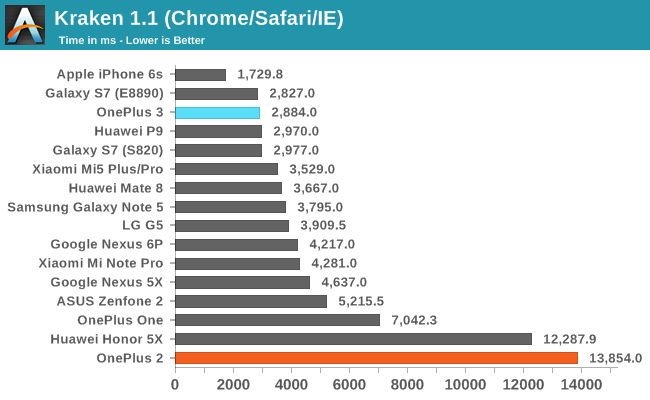
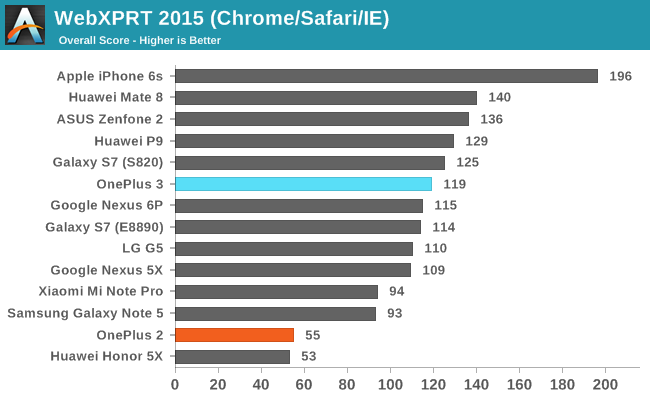
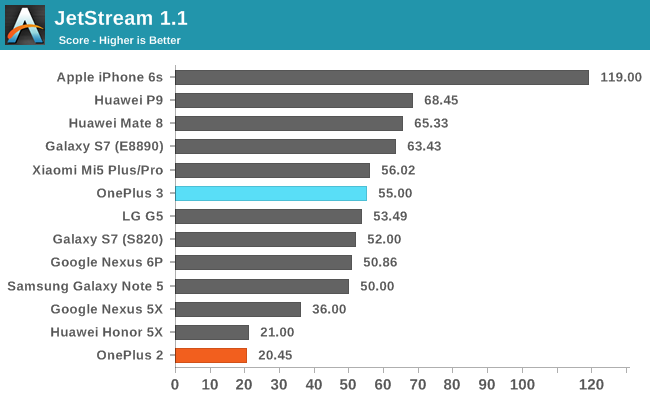
The improvement in web browsing performance when going from the OnePlus 2 to the OnePlus 3 is staggering. This isn't unexpected when you consider that the OnePlus 2 was just running on Cortex A53 cores that were meant for low power scenarios while the OnePlus 3 is using Qualcomm's Kryo cores. In Kraken the OnePlus 3 is over four times faster, while in WebXPRT and JetStream it's at least over two times faster. The OnePlus 2 actually represented a large regression in web performance compared to its predecessor, and OnePlus has brought web performance back to a level that is competitive with the other smartphones on the market with the OnePlus 3.

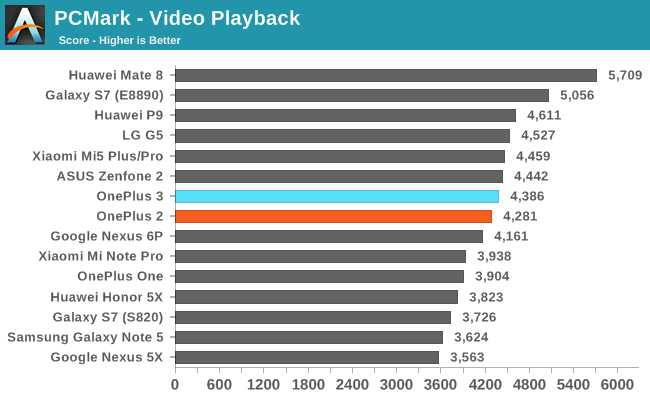

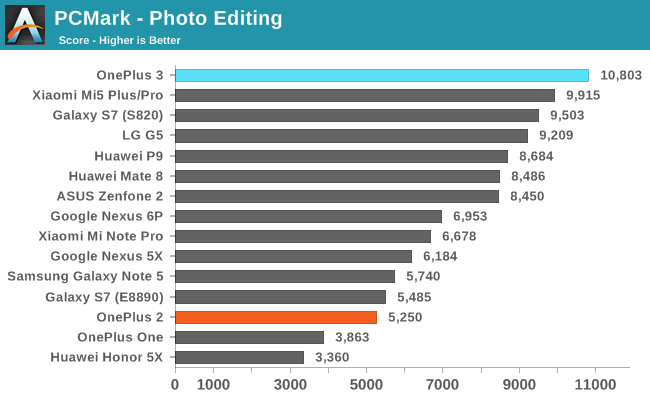
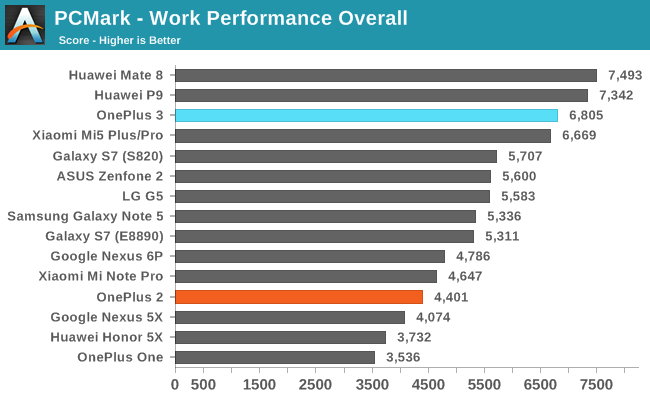
PCMark is an interesting test because it depends just as much on a phone's software as it does on the hardware. We've seen how devices with the same SoC can perform very differently, especially in certain sub-tests like the Writing and Photo Editing tests where different runtime and OS optimizations can have a large impact. The OnePlus 3 is no exception, with it achieving higher scores than the LG G5 in every test except for video playback where they have roughly the same scores.
This is not unexpected, as it was demonstrated in the LG G5 review that the G5 has more conservative frequency scaling than the other Snapdragon 820 devices that we've seen, which is reflected in PCMark's tests. In any case, the OnePlus 3 actually gets close to the Huawei Mate 8 in the writing test, and beats it and the LG G5 by a large margin in the photo editing test. In the end the OnePlus 3 places second on our overall chart, with only the Huawei Mate 8 ahead of it, and the gap between it and the Mate 8 being smaller than the gap between it and the Zenfone 2 which is the next fastest smartphone.
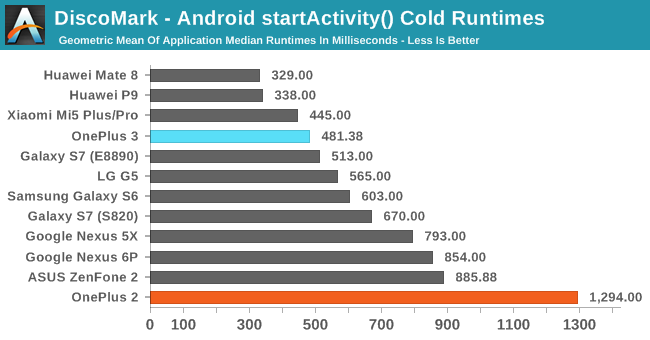
The OnePlus 3 is over two times faster than the OnePlus 2 with cold app launches where the application isn't resident in memory in any state. This is likely a combination of improved NAND performance, and changes to OnePlus's DVFS settings in addition to the performance improvements that Snapdragon 820 provides on its own. The impact that this has on the performance of the interface is significant, and when I reviewed the OnePlus 2 I noted how painfully slow it was to move around and through the applications. This new testing is a great example of that, with the OnePlus 2 taking 1.3 seconds just to launch apps, while the OnePlus 3 takes under 500ms and is the second fastest device here.
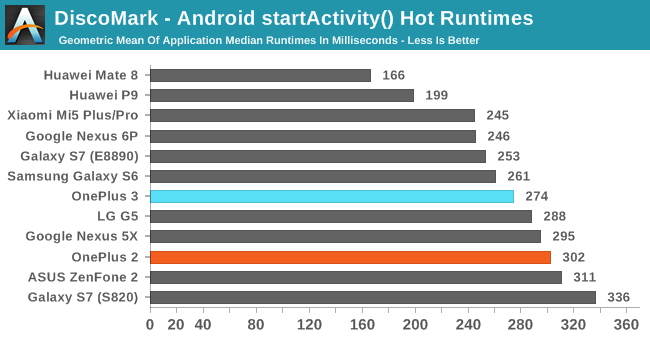
The OnePlus 3 improves a bit over the OnePlus 2 when resuming apps that are resident in memory, but not by a great deal. In general, all our devices hover between 250 and 300ms here, with the exception of the Huawei Mate 8 and P9 which are really in a category of their own for performance. While there's no enormous improvement here, the OnePlus 3 is competitive with other high end devices in the market, so there's nothing to complain about either.
One thing worth noting is that our set of apps wouldn't come close to utilizing the OnePlus 3's 6GB of RAM. Unfortunately, no matter how many apps we added, this would actually still be the case. The reason is that OnePlus has implemented very aggressive app eviction from memory, which means that your 6GB of RAM is really just sitting there using energy, and in general the utilization is pretty low. This may be a holdover from when the OnePlus 2 shipped in a 3GB configuration, but it's something OnePlus needs to address in a future OTA update. I'd imagine the Android enthusiast community is already at work on, or has already created custom kernels to alter this behavior as well. With 6GB of RAM you should be able to comfortably keep all of a user's frequently used apps resident in memory.
It's great to see that OnePlus is producing a smartphone with competitive performance once again. When the OnePlus One launched, Snapdragon 801 was the best you could get in an Android smartphone. The OnePlus 2 was an unfortunate victim of Snapdragon 810's heat and throttling problems, but OnePlus certainly didn't help the issue by hardcoding in mechanisms to detect Google Chrome and shut the A57 cluster off entirely. With the OnePlus 3 you get some of the best CPU performance in an Android phone, with PCMark's real-world tests demonstrating noticeable gains over the LG G5 which also uses Snapdragon 820. If I had to sum things up in a single line I'd just say that it's good to see that OnePlus is back in the game.


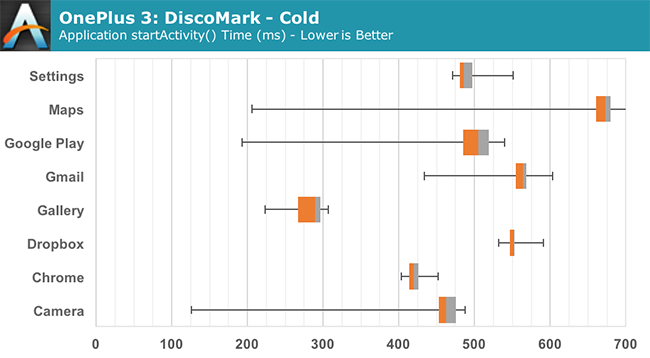
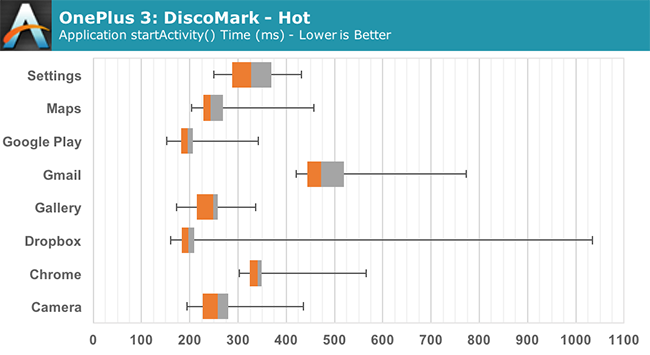








176 Comments
View All Comments
greyhulk - Monday, June 20, 2016 - link
Bragging that your phone has 6GB of RAM, while knowing that you gimped it so that it doesn't utilized it is pure insanity. The co-founder has gone on record saying this was intentional to save battery (yet the put a smaller battery in). I would have thought that the flack that Samsung received last year over their aggressive RAM management would have given OnePlus pause, but it's almost like they don't even have their finger on the pulse of the mobile industry. Let's face it: Price or not, this is more of an enthusiast device than anything and the enthusiasts were very loudly condemning the aggressive RAM management phones last year. They had to know this was going to blow up in their faces. I'm glad there's an easy fix. Heck, you couldn't even root most models of the GS6 to fix the issue, but it never should have shipped this way.UtilityMax - Sunday, June 26, 2016 - link
They should have included a brighter screen or an sd card slot instead of wasting resources on more RAM. Another proof that many android smartphone vendors chase superfluous paper specs instead of addressing issues that the users really have.rxzlmn - Monday, June 20, 2016 - link
'The OnePlus 2 and the OnePlus 3 both use USB Type-C connectors, but they only implement the USB 2.0 protocol so there's no support for USB Power Delivery either.'The power specifications have nothing to do with the supported USB protocol, this sentence is false. In fact, both the Nexus 5X as well as the Nexus 6P do not support USB 3.
Brandon Chester - Monday, June 20, 2016 - link
That's correct, the Nexus 5X and 6P are just USB2 as well. I've amended that sentence, thanks for pointing it out.jjj - Monday, June 20, 2016 - link
Where are my subpixels! And the microSD and what's with the display's accuracy, that home button and design?That aside, the RAM management is the funniest thing ever. You got 6GB but you are not allowed to use it as only 3-4 apps are allowed to stay open.
Pricing is not great compared to OP1, this one is a lot less value considering.
The devices you guys include in the charts make you seem partial. You include few last gen devices and that has to be on purpose as you don't usually do that.
Fast charging related ,Mediatek just did a demo in China for their Pump Express 3.0, they had a 5.8V/6A charger (so 34.8W) and got to 83% in 27 mins- the marketing claims 70% in 20mins.
tipoo - Monday, June 20, 2016 - link
What's the charge cycle rating on a battery that charges to 83% in 27 minutes?jospoortvliet - Monday, June 20, 2016 - link
Depends on how you manage heat and how far you push it. Take a 3500mah battery, never charge above 90% and even if you charge it to 75% in 15 min and trickle from there to the 90% you will be fine from a life expectancy perspective I bet.Dr. Swag - Monday, June 20, 2016 - link
I think you've made a mistake... On the first page you stated multiple times that the oneplus 2 has a microsd card slot but it doesn't... It only has dual sim.osxandwindows - Monday, June 20, 2016 - link
So, no gs7 review?ok
dishayu - Monday, June 20, 2016 - link
Any chance of doing some audio benchmarking as well when reviewing smartphones? I'm specifically referring to audio-quality for headphones/earphones, since many (most) people use their phones as media player these days. Phones vary in capabilities vastly, from Vivo X-play5 with a DAC that costs 40$ on its own to many other flagships using a basic Qualcomm codec.